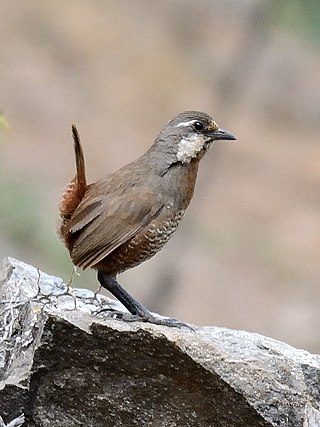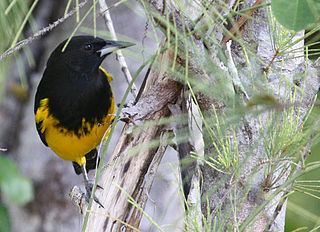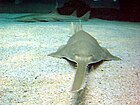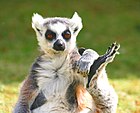Related Research Articles

Grouse are a group of birds from the order Galliformes, in the family Phasianidae. Grouse are presently assigned to the tribe Tetraonini, a classification supported by mitochondrial DNA sequence studies, and applied by the American Ornithologists' Union, ITIS, International Ornithological Congress, and others.

The International Union for Conservation of Nature (IUCN) Red List of Threatened Species, also known as the IUCN Red List or Red Data Book, founded in 1964, is an inventory of the global conservation status and extinction risk of biological species. A series of Regional Red Lists are produced by countries and organizations, which assess the risk of extinction to species within a political management unit.

The bluebirds are a North American group of medium-sized, mostly insectivorous or omnivorous birds in the order of Passerines in the genus Sialia of the thrush family (Turdidae). Bluebirds are one of the few thrush genera in the Americas.

The tapaculos or tapacolos are a family, Rhinocryptidae, of small suboscine passerine birds, found mainly in South America and with the highest diversity in the Andean regions. Three species are found in southern Central America.

Threatened species are any species which are vulnerable to extinction in the near future. Species that are threatened are sometimes characterised by the population dynamics measure of critical depensation, a mathematical measure of biomass related to population growth rate. This quantitative metric is one method of evaluating the degree of endangerment.

The genus Dendragapus contains two closely related species of grouse that have often been treated as a single variable taxon. The two species are the dusky grouse and the sooty grouse. In addition, the spruce grouse and Siberian grouse have been considered part of this genus.

The yelkouan shearwater, Levantine shearwater or Mediterranean shearwater is a medium-sized shearwater in the seabird family Procellariidae. It was formerly treated as a subspecies of the Manx shearwater.

The gang-gang cockatoo is a parrot found in the cooler and wetter forests and woodlands of Australia, particularly alpine bushland. It is the only species placed in the genus Callocephalon. Mostly mild grey in colour with some lighter scalloping, the male has a red head and crest, while the female has a small fluffy grey crest. It ranges throughout south-eastern Australia. The gang-gang cockatoo is the faunal emblem of the Australian Capital Territory. It is easily identified by its distinctive call, which is described as resembling a creaky gate, or the sound of a cork being pulled from a wine bottle.

An Important Bird and Biodiversity Area (IBA) is an area identified using an internationally agreed set of criteria as being globally important for the conservation of bird populations.

The NatureServe conservation status system, maintained and presented by NatureServe in cooperation with the Natural Heritage Network, was developed in the United States in the 1980s by The Nature Conservancy (TNC) as a means for ranking or categorizing the relative imperilment of species of plants, animals, or other organisms, as well as natural ecological communities, on the global, national or subnational levels. These designations are also referred to as NatureServe ranks, NatureServe statuses, or Natural Heritage ranks. While the Nature Conservancy is no longer substantially involved in the maintenance of these ranks, the name TNC ranks is still sometimes encountered for them.

The conservation status of a group of organisms indicates whether the group still exists and how likely the group is to become extinct in the near future. Many factors are taken into account when assessing conservation status: not simply the number of individuals remaining, but the overall increase or decrease in the population over time, breeding success rates, and known threats. Various systems of conservation status are in use at international, multi-country, national and local levels, as well as for consumer use such as sustainable seafood advisory lists and certification. The two international systems are by the International Union for Conservation of Nature IUCN and The Convention on International Trade in Endangered Species of Wild Fauna and Flora (CITES)

The spectacled petrel is a rare seabird that nests only on the high western plateau of Inaccessible Island in the South Atlantic Tristan da Cunha group. It is one of the largest petrels that nests in burrows. This species was formerly considered to be a subspecies of the white-chinned petrel.

The shy albatross, also known as shy mollymawk,, is a medium-sized albatross that breeds on three remote islands off the coast of Tasmania, Australia, in the southern Indian Ocean. Its lifespan is about 60 years, and it has been seen as far afield as South Africa and the Pacific coast of the United States. As of June 2020, the species is listed as "Endangered" in Australia; there are thought to be 15,000 pairs of shy albatross left. It is Australia's only endemic albatross.

A near-threatened species is a species which has been categorized as "Near Threatened" (NT) by the International Union for Conservation of Nature (IUCN) as that may be vulnerable to endangerment in the near future, but it does not currently qualify for the threatened status.

The Bahama swallow is an endangered swallow endemic to The Bahamas.

The mallee emu-wren is a species of bird in the Australasian wren family, Maluridae. It is endemic to Australia.

A vulnerable species is a species which has been categorized by the International Union for Conservation of Nature as being threatened with extinction unless the circumstances that are threatening its survival and reproduction improve.

The Bahama oriole is a species of songbird in the New World blackbird family Icteridae. It is endemic to the Bahamas, and listed as endangered by the IUCN Red List.
British Columbia hosts 22 species of native and introduced salmonids. This list reflects the conservation status of British Columbia salmonids. Status from BC Species and Ecosystems Explorer. Status definitions from NatureServe.

Endangered species as classified by the International Union for Conservation of Nature (IUCN), are species which have been categorized as very likely to become extinct in their known native ranges in the near future. On the IUCN Red List, endangered is the second-most severe conservation status for wild populations in the IUCN's schema after critically endangered. In 2012, the IUCN Red List featured 3,079 animal and 2,655 plant species as endangered worldwide. The figures for 1998 were 1,102 and 1,197 respectively.
References
- ↑ "The A. O. U. Check-List of North American Birds. Third Edition Check-List of North American Birds American Ornithologists' Union Abridged Check-List of North American Birds American Ornithologists' Union". The Auk. 27 (4): 466–472. October 1910. doi:10.2307/4070921. ISSN 0004-8038. JSTOR 4070921.
- ↑ "The Blue List". web.stanford.edu. Retrieved 2022-12-04.
- ↑ García, Eusebio Alonso (2018). "JAMES STIRLING Y EL PROYECTO DE LA TATE GALLERY EN ALBERT DOCK, LIVERPOOL, 1982–88 / JAMES STIRLING AND THE TATE GALLERY PROJECT IN ALBERT DOCK, LIVERPOOL, 1982–88". Proyecto, Progreso, Arquitectura (19): 134–149. doi: 10.12795/ppa.2018.i19.08 . ISSN 2171-6897.
- ↑ Strategy, Ministry of Environment and Climate Change. "Conservation Status Ranks - Province of British Columbia". www2.gov.bc.ca. Retrieved 2022-12-04.


